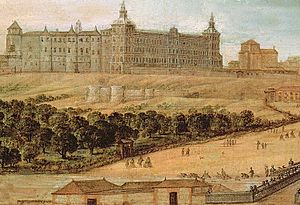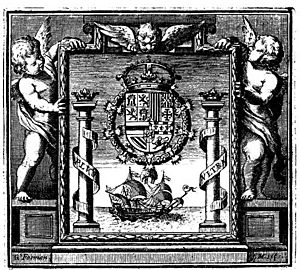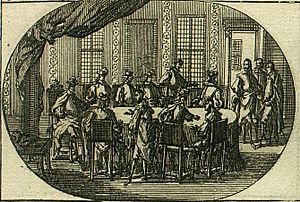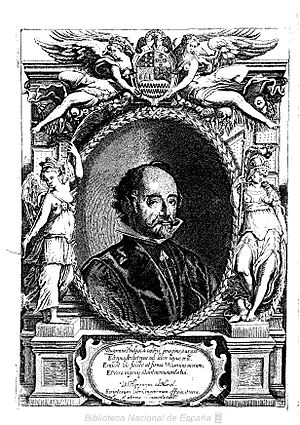Council of the Indies facts for kids

The Council of the Indies (Spanish: Consejo de las Indias) was a very important group in the Spanish Empire. Its full name was the Royal and Supreme Council of the Indies. This council helped the King of Spain rule his lands in the Americas and other places like the Spanish East Indies.
The King had total power over these faraway lands. The Council of the Indies was like his main helper. It gave him advice and managed everything. Charles V created it in 1524. He wanted a special group to look after Spain's new territories, which they called "the Indies." This became very important after Spain conquered the Aztec empire in 1521.
At first, the Council moved around with Charles V. But later, Philip II of Spain made it a fixed group with its own powers. It handled laws, managed the government, and acted as a court. In 1561, it was set up permanently in Madrid. The Council of the Indies was closed down in 1812. It was briefly brought back in 1814 but then finally ended in 1834.
History of the Council

When Spain first explored the Americas, Queen Isabella gave a lot of power to Christopher Columbus. But she soon took that power away. Instead, she put her chaplain, Juan Rodríguez de Fonseca, in charge of the Indies in 1493.
Queen Isabella and King Ferdinand (known as the Catholic Monarchs) asked Rodríguez de Fonseca to fix problems in the new colonies. There were issues with how Governor Columbus treated both Native people and Spanish settlers. Rodríguez de Fonseca became like a minister for the Indies. He helped create the first rules for how the colonies would be run. He led a small group, or Junta de Indias, of about eight advisors. By 1519, Emperor Charles V was already using the name "Council of the Indies."
The Council of the Indies was officially created on August 1, 1524. The King received updates from the Council every week, sometimes even daily. The Council had the highest power over the Indies. It also oversaw the Casa de Contratación (House of Trade), which was set up in Seville in 1503. This "House of Trade" was like a customs office for goods coming from the Indies.
Important legal cases from the New World could be sent to the Council. It acted like a supreme court, making the final decisions. The Council had two main secretaries. One managed lands like Mexico, Guatemala, and the Spanish East Indies. The other managed Peru, Chile, and northern South America. The Council's name stayed the same even when new lands in the East Indies and Pacific were added.
There were many problems in Peru, and Bartolomé de las Casas worked hard to protect the rights of Native people. Because of this, Charles V changed how the Council worked in 1542. He issued the "New Laws." These laws limited the power of Spanish settlers who had encomiendas, which were grants of Native labor.
Later, under Charles II, the Council worked to organize all the laws for the Indies. This led to the creation of the Laws of the Indies (Recopilación de las Leyes de Indias) in 1680. These laws were updated again in 1791.
The Council of the Indies was usually led by a church leader. But most of its members were lawyers, not priests. Later, some nobles and royal friends also joined. Many members had experience working in the high courts (Audiencias) in the Indies. A good example was Juan de Solórzano Pereira. He wrote an important book called Política Indiana. He worked in Peru before joining the Council and helped create the Laws of the Indies. Other important leaders of the Council included Pedro Moya de Contreras (a former archbishop of Mexico) and Luis de Velasco, marqués de Salinas (a former viceroy of both Mexico and Peru).
At first, the Council handled everything about the Indies. But under Philip II, the money matters were moved to the Council on Finance in 1556-57. This caused arguments between the two councils, especially since Spanish America became the main source of Spain's wealth. When the Inquisition was set up in Mexico and Lima in the 1570s, the Council of the Indies no longer controlled it.
The Council was most powerful in the 1500s. Its power slowly went down, and the quality of its members decreased. Towards the end of the Habsburg family's rule, some positions were even sold. Sometimes, people who were not qualified, like a nine-year-old boy, were given jobs on the Council.
When the Bourbon dynasty came to power in the 1700s, they made many changes. These were called the Bourbon reforms. In 1714, Philip V created a new office called the Secretariat of the Navy and the Indies. This office took over many of the Council's daily tasks. The Council still existed but had a smaller role. Fifty years later, Charles III created a separate Secretary of State for the Indies.
In the late 1700s, the Council became powerful and respected again. Many qualified members with experience in the Indies joined. But in 1808, Napoleon invaded Spain. The Cortes of Cádiz, which was the Spanish government at the time, closed the Council in 1812. It was brought back in 1814 when Ferdinand VII returned to the throne. He appointed many members who had worked in the Americas. The Council was finally closed for good in 1834. This was a year after Ferdinand VII died, and after most of Spain's empire in the Americas became independent.
The old records of the Council are kept in the Archivo General de Indias in Seville. This archive is a very important place for studying the history of Spain, Spanish America, and Europe.
See also
 In Spanish: Consejo de Indias para niños
In Spanish: Consejo de Indias para niños






